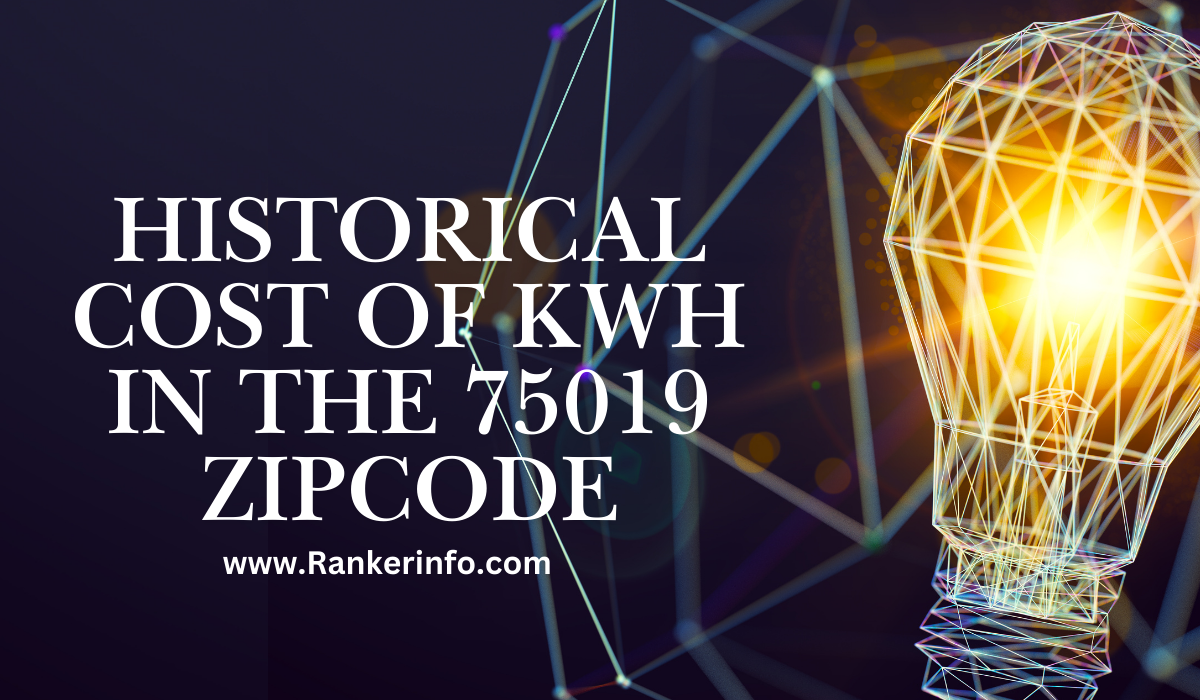Historical cost of kwh in the 75019 zipcode . Understanding the historical cost of kilowatt-hours (kWh) in the 75019 zipcode, which includes parts of Flower Mound, Texas, is vital for residents looking to manage their electricity expenses effectively. This article provides a comprehensive analysis of how electricity prices have evolved over the years, examining various factors that influence costs, trends, and potential strategies for managing electricity bills. By the end, readers will have a clearer understanding of the historical pricing landscape and how it affects their daily lives.
Table of Contents
ToggleOverview of the 75019 Zipcode
Geographic and Demographic Context
The 75019 zipcode encompasses areas in Flower Mound, a suburban community located in Denton and Tarrant Counties. With a population of around 76,000 residents, Flower Mound is known for its family-friendly atmosphere, excellent schools, and abundant parks and recreational opportunities. The city’s growth has been closely linked to the broader economic development in the Dallas-Fort Worth metroplex, making it a desirable location for families and businesses alike.
Energy Providers
Residents in the 75019 zipcode have access to various electricity providers due to Texas’s deregulated energy market. This deregulation allows consumers to choose their electricity supplier, which can lead to competitive pricing and a variety of plan options. Some of the main energy providers in the area include Oncor Electric Delivery, TXU Energy, and Reliant Energy, among others. Each provider offers different rates, plans, and incentives that can significantly impact the cost of electricity.
Historical Cost Trends of kWh in the 75019 Zipcode
Average kWh Costs Over the Years
The cost of electricity in the 75019 zipcode has experienced notable fluctuations over the past decade. To provide a clearer picture of these trends, we can examine historical data from the U.S. Energy Information Administration (EIA) and local utility providers.
| Year | Average Cost per kWh |
|---|---|
| 2012 | $0.10 |
| 2013 | $0.11 |
| 2014 | $0.11 |
| 2015 | $0.11 |
| 2016 | $0.12 |
| 2017 | $0.12 |
| 2018 | $0.12 |
| 2019 | $0.13 |
| 2020 | $0.13 |
| 2021 | $0.13 |
| 2022 | $0.14 |
| 2023 | $0.15 |
From the table, we see that the average cost per kWh rose from $0.10 in 2012 to around $0.15 in 2023, indicating a steady upward trend. Several factors contribute to this increase, which will be discussed in detail later in this article.
Seasonal Variations in Electricity Costs
Electricity prices in the 75019 zipcode also exhibit seasonal variations. During peak demand periods, such as summer months, when air conditioning usage is high, electricity rates often rise. Conversely, costs may decrease in the winter months when demand typically declines.
Monthly Average kWh Costs
| Month | Average Cost per kWh |
|---|---|
| January | $0.12 |
| February | $0.12 |
| March | $0.11 |
| April | $0.11 |
| May | $0.12 |
| June | $0.14 |
| July | $0.15 |
| August | $0.15 |
| September | $0.14 |
| October | $0.13 |
| November | $0.12 |
| December | $0.12 |
The above table illustrates that electricity costs tend to peak in the summer months, reflecting higher demand for cooling.
Factors Influencing Electricity Pricing
Supply and Demand Dynamics
Electricity pricing is fundamentally influenced by supply and demand dynamics. During periods of high demand, such as extreme weather conditions, prices tend to increase. Conversely, during times of lower demand, prices may stabilize or decrease.
Energy Source Composition
Texas has a diverse energy portfolio that includes natural gas, coal, wind, and solar power. Changes in the energy mix can significantly impact electricity costs. For example, fluctuations in natural gas prices often lead to corresponding changes in electricity rates. As of 2022, natural gas accounted for approximately 45% of Texas’s electricity generation, while renewables, particularly wind energy, contributed around 25%.
Regulatory Environment
The regulatory environment in Texas is unique due to the state’s deregulated energy market. While this deregulation allows for competition among electricity providers, it also means that prices can fluctuate based on market conditions. Changes in regulations, such as environmental standards and tariffs, can affect the operational costs for utility providers, which are ultimately passed on to consumers.
Infrastructure Costs
The costs associated with maintaining and upgrading the electricity infrastructure also play a role in pricing. As demand grows, utility companies must invest in enhancing their infrastructure, such as power lines and substations. These costs are typically reflected in the rates charged to consumers.
Impact of External Events on kWh Costs
Weather Events and Natural Disasters
Extreme weather events can have a significant impact on electricity prices. For instance, the winter storm in February 2021 caused widespread power outages across Texas, leading to dramatic spikes in electricity prices. During this crisis, some consumers experienced electricity rates soaring to as high as $9 per kWh due to the unprecedented demand and strained grid conditions.
Economic Factors
Economic conditions also influence electricity pricing. For example, during economic downturns, demand for electricity may decrease, potentially leading to lower prices. Conversely, economic growth can drive demand for energy, resulting in higher prices.
Comparing kWh Costs with National Averages
To provide context for the historical kWh costs in the 75019 zipcode, it’s useful to compare these figures with national averages.
| Year | National Average Cost per kWh | Texas Average Cost per kWh |
|---|---|---|
| 2012 | $0.11 | $0.10 |
| 2013 | $0.12 | $0.11 |
| 2014 | $0.12 | $0.11 |
| 2015 | $0.13 | $0.11 |
| 2016 | $0.13 | $0.12 |
| 2017 | $0.13 | $0.12 |
| 2018 | $0.13 | $0.12 |
| 2019 | $0.13 | $0.13 |
| 2020 | $0.13 | $0.13 |
| 2021 | $0.14 | $0.13 |
| 2022 | $0.15 | $0.14 |
| 2023 | $0.16 | $0.15 |
As shown in the table, Texas electricity rates are often comparable to or slightly below the national average. However, the trend indicates that Texas has experienced a gradual increase over the years.
Strategies for Managing Electricity Costs
With the upward trend in kWh costs, residents of the 75019 zipcode can adopt several strategies to manage their electricity expenses effectively.
Energy Efficiency Upgrades
Investing in energy-efficient appliances and systems can significantly reduce electricity consumption. ENERGY STAR-rated appliances use less energy, leading to lower monthly bills.
Smart Home Technology
Smart home technologies, such as programmable thermostats and smart plugs, can help residents manage their energy usage more effectively. By automating heating and cooling based on occupancy patterns, homeowners can save money.
Utilizing Time-of-Use Plans
Many utility companies offer time-of-use pricing plans, which charge different rates depending on the time of day. By shifting energy-intensive activities to off-peak hours, residents can save on their electricity bills.
Exploring Renewable Energy Options
Residents may consider installing solar panels to harness renewable energy. Texas offers various incentives and rebates for homeowners interested in transitioning to solar energy, which can reduce long-term electricity costs.
Factors Influencing Electricity Costs
Understanding the reasons behind fluctuating electricity costs is essential. Several factors contribute to this phenomenon:
Supply and Demand
Increased demand for electricity during peak seasons can lead to higher prices. During summer months, for example, air conditioning usage spikes, driving up the overall demand for energy.
Energy Sources
The energy mix used to generate electricity plays a significant role in pricing. Texas relies heavily on natural gas and renewable energy sources, such as wind and solar. Changes in the availability and cost of these resources directly impact electricity prices.
Regulatory Changes
Government regulations, such as changes in tariffs or environmental policies, can affect the operational costs of utility providers. These changes are often passed down to consumers in the form of higher rates.
Infrastructure Costs
Upgrades and maintenance of electrical infrastructure, including power lines and substations, can result in increased operational costs. Utility companies may increase rates to cover these expenses.
Recent Trends in kWh Costs in 75019
Short-Term Fluctuations
The short-term fluctuations in kWh costs can be attributed to various seasonal factors. For instance, extreme weather events can lead to spikes in electricity demand, resulting in temporary price increases. In February 2021, Texas experienced severe winter storms that significantly impacted electricity pricing across the state.
Long-Term Trends
Over the past decade, long-term trends indicate a steady increase in electricity costs. According to the EIA, Texas has experienced a 30% increase in electricity rates from 2012 to 2022, emphasizing the need for residents to remain vigilant regarding their energy consumption and budgeting.
How to Manage Your Electricity Costs
While understanding historical kWh prices is essential, implementing strategies to manage costs is equally important. Here are some effective methods for residents of the 75019 zipcode:
Energy Efficiency
Investing in energy-efficient appliances and lighting can significantly reduce electricity usage. Look for the ENERGY STAR label when purchasing new products to ensure energy efficiency.
Smart Home Technology
Using smart home devices, such as programmable thermostats, can help manage energy consumption more effectively. These devices allow users to optimize heating and cooling settings based on their daily schedules.
Time-of-Use Pricing Plans
Many utility providers offer time-of-use pricing plans, which charge different rates based on the time of day. By shifting energy-intensive tasks to off-peak hours, residents can save on their electricity bills.
Renewable Energy Options
Residents may consider investing in solar panels or other renewable energy sources to offset their electricity costs. Programs and incentives available in Texas can assist homeowners in this transition.
FAQs about the Historical Cost of kWh in the 75019 Zipcode
What is the average cost of kWh in the 75019 zipcode?
As of 2023, the average cost of kWh in the 75019 zipcode is approximately $0.15, reflecting an upward trend over the past decade.
What factors contribute to fluctuations in electricity costs?
Fluctuations in electricity costs are influenced by supply and demand dynamics, the energy source composition, regulatory changes, and infrastructure costs.
How do Texas electricity prices compare to national averages?
Texas electricity prices are generally comparable to national averages, often being slightly lower, but have shown a consistent upward trend.
What strategies can residents use to lower their electricity bills?
Residents can reduce their electricity bills by upgrading to energy-efficient appliances, using smart home technology, participating in time-of-use pricing plans, and exploring renewable energy options.
How did the February 2021 winter storm affect electricity prices in Texas?
The February 2021 winter storm caused significant spikes in electricity prices, with some consumers experiencing rates as high as $9 per kWh due to unprecedented demand and grid strain
Conclusion
The historical cost of kWh in the 75019 zipcode reflects broader trends in energy pricing, influenced by supply and demand dynamics, economic factors, and external events such as weather disasters. By understanding these trends and exploring strategies for managing energy costs, residents can make informed decisions to optimize their electricity consumption and reduce expenses. The evolving landscape of electricity pricing in Texas highlights the importance of staying informed about local rates and available options to ensure efficient energy use.
Also read more : synopsis of things we never got over

